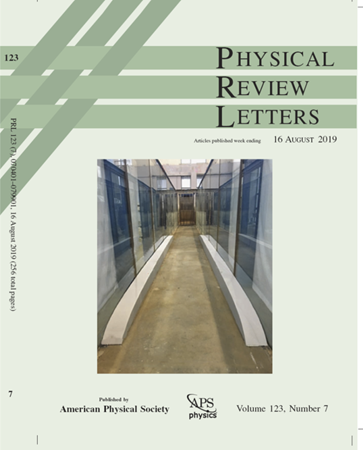Nested Stochastic Resetting: Nonequilibrium Steady States and Exact Correlations
IF 9
1区 物理与天体物理
Q1 PHYSICS, MULTIDISCIPLINARY
引用次数: 0
Abstract
Stochastic resetting breaks detailed balance and drives the formation of nonequilibrium steady states. Here, we consider a chain of diffusive processes xi(t) that interact unilaterally: at random time intervals, the process嵌套随机重置:非平衡稳态和精确相关性
随机重置打破了详细的平衡,驱动了非平衡稳态的形成。这里,我们考虑一个单方面相互作用的扩散过程链xi(t):在随机时间间隔,过程xn随机重置为xn−1的瞬时值。我们解析地导出了这些嵌套随机重置过程的稳态统计量,包括每个过程及其矩的平稳分布。我们还能够通过将问题映射到随机计数过程的一个排序统计量来精确地计算过程之间的稳态两点相关性⟨xnxn+j⟩。理解多粒子非平衡系统中的统计和相关性仍然是一个艰巨的挑战,我们的结果提供了这种可处理相关性的一个例子。我们期望这个框架将有助于为具有单边交互的随机过程建立一个模型独立的框架,并找到直接的应用,例如,在有损信息传播的建模中。
本文章由计算机程序翻译,如有差异,请以英文原文为准。
求助全文
约1分钟内获得全文
求助全文
来源期刊

Physical review letters
物理-物理:综合
CiteScore
16.50
自引率
7.00%
发文量
2673
审稿时长
2.2 months
期刊介绍:
Physical review letters(PRL)covers the full range of applied, fundamental, and interdisciplinary physics research topics:
General physics, including statistical and quantum mechanics and quantum information
Gravitation, astrophysics, and cosmology
Elementary particles and fields
Nuclear physics
Atomic, molecular, and optical physics
Nonlinear dynamics, fluid dynamics, and classical optics
Plasma and beam physics
Condensed matter and materials physics
Polymers, soft matter, biological, climate and interdisciplinary physics, including networks
 求助内容:
求助内容: 应助结果提醒方式:
应助结果提醒方式:


